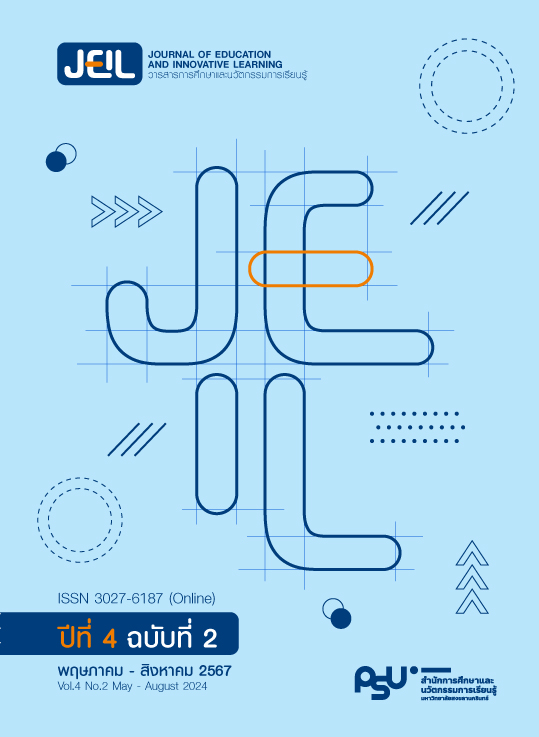การรับรู้ของครูระดับประถมศึกษาในโรงเรียนตำรวจตระเวนชายแดนต่อการใช้บาร์โมเดลในการแก้ปัญหาทางคณิตศาสตร์
Main Article Content
บทคัดย่อ
การอบรมเชิงปฏิบัติการรูปแบบออนไลน์เพื่อแนะนำการใช้บาร์โมเดล ซึ่งเป็นยุทธวิธีในการแก้ปัญหาทางคณิตศาสตร์ได้จัดขึ้น 2 ครั้ง ให้กับครูคณิตศาสตร์ระดับประถมศึกษาในโรงเรียนตำรวจตระเวนชายแดน (ตชด.) ที่อยู่ในพื้นที่ห่างไกล ซึ่งครู ตชด. เหล่านี้มีประสบการณ์การสอนที่จำกัด ดังนั้น การจัดการเรียนรู้เรื่องการแก้ปัญหาทางคณิตศาสตร์ซึ่งเป็นหัวข้อที่ยากสำหรับนักเรียนหลายคนจึงเป็นงานที่ท้าทาย งานวิจัยนี้มุ่งเน้นที่ศึกษาประสิทธิผลของการจัดการอบรมเชิงปฏิบัติการในรูปแบบออนไลน์และการรับรู้ของครู ตชด. ที่มีต่อการใช้บาร์โมเดลเพื่อเป็นยุทธวิธีในการแก้ปัญหา แบบสอบถามรูปแบบออนไลน์ถูกใช้ในการเก็บรวบรวมข้อมูลจากครูที่เข้าร่วมในงานวิจัย 333 คน หลังจากการอบรม ผลแสดงให้เห็นว่าครูมีทัศนคติเชิงบวกต่อการใช้บาร์โมเดล ครูส่วนใหญ่สะท้อนว่าพวกเขาสามารถใช้บาร์โมเดลในการแก้ปัญหาด้วยตนเองได้ และคิดว่าบาร์โมเดลสามารถใช้ส่งเสริมความสามารถในการแก้ปัญหาของนักเรียน เป็นเครื่องมือที่มีประโยชน์ในการทำให้เห็นภาพและทำความเข้าใจโจทย์ปัญหา ถึงแม้ว่าครูส่วนใหญ่ต้องการนำบาร์โมเดลไปใช้ในการจัดการเรียนรู้แต่ก็มองเห็นว่าอาจมีข้อจำกัดบางประการ เช่น ความเข้าใจในวิธีการใช้บาร์โมเดลของครู และอุปสรรคทางภาษาของนักเรียน ซึ่งข้อจำกัดเหล่านี้เป็นความท้าทายที่ครูต้องเผชิญ นอกจากนี้ ครูสะท้อนถึงความต้องการเกี่ยวกับหลักสูตรการอบรมเพิ่มเติมเพื่อทบทวนวิธีการใช้บาร์โมเดล รวมทั้งทรัพยากรและสื่อเพิ่มเติมอื่น ๆ เช่น แผนการสอนและใบงานของนักเรียน บทความนี้มีการสรุปผลและให้ข้อเสนอแนะเกี่ยวกับการออกแบบการเรียนรู้เพื่อสนับสนุนการใช้บาร์โมเดลของครู ตชด. ต่อไปในอนาคต
Article Details

อนุญาตภายใต้เงื่อนไข Creative Commons Attribution-NonCommercial-NoDerivatives 4.0 International License.
เนื้อหาและข้อมูลในบทความที่ตีพิมพ์ในวารสารการศึกษาและนวัตกรรมการเรียนรู้ ถือเป็นข้อคิดเห็นและความรับผิดชอบของผู้เขียน ซึ่งกองบรรณาธิการวารสาร ไม่จำเป็นต้องเห็นด้วยหรือร่วมรับผิดชอบใด ๆ และไม่สงวนสิทธิ์การคัดลอกบทความเพื่อใช้ประโยชน์ทางวิชาการ แต่ให้อ้างอิงข้อมูลแสดงที่มาของบทความทุกครั้งที่นำไปใช้ประโยชน์
เอกสารอ้างอิง
Chairhit T. (2021). Guidelines for teaching skills development of teachers of border patrol police schools. MCU Haripunchai Review, 4(2), 45-54. Retrieved from https://so04.tci-thaijo.org/index.php/JMHR/article/view/247772 [in Thai]
Cohen, L., Manion, L., & Morrison, K. (2017). Research methods in education. Routledge.
Creswell, J. W. (2014). Educational research: Planning, conducting, and evaluating quantitative and qualitative research (4th ed.). Pearson Education.
de Koning, B. B., Boonen, A. J., Jongerling, J., van Wesel, F., & van der Schoot, M. (2022). Model method drawing acts as a double-edged sword for solving inconsistent word problems. Educational Studies in Mathematics, 111(1), 29-45. doi:10.1007/s10649-022-10150-8
Dindyal, J. (2006, July 1-5). The Singaporean mathematics curriculum: Connections to TIMSS. In Proceedings of the 29th Annual Conference of the Mathematics Education Research Group of Australasia (179-186). Adelaide: MERGA Inc.
Goh, S. P. (2009). Primary 5 pupils’ difficulties in using the model method for solving complex relational word problems (Master’s thesis). National Institute of Education, Nanyang Technological University, Singapore.
Hyun, S. (2014). Building a human border: The Thai border patrol police school project in the post–cold war era. Journal of Social Issues in Southeast Asia, 29(2), 332-363. doi:10.1355/sj29-2d
Ingvarson, L., Meiers, M., & Beavis, A. (2005). Factors affecting the impact of professional development programs on teachers’ knowledge, practice, student outcomes & efficacy. Education Policy Analysis Archives, 13, 10. doi:10.14507/epaa.v13n10.2005
Kho, T. H., Yeo, S. M., & Lim, J. (2009). The Singapore Model Method for Learning Mathematics. Singapore: EPB Pan Pacific.
Kaur, B. (2019). The why, what and how of the ‘Model’ method: A tool for representing and visualising relationships when solving whole number arithmetic word problems. ZDM, 51(1), 151-168. doi:10.1007/s11858-018-1000-y
Morin, L. L., Watson, S. M. R., Hester, P., & Raver, S. (2017). The use of a bar model drawing to teach word problem solving to students with mathematics difficulties. Learning Disability Quarterly, 40(2), 91-104. doi:10.1177/0731948717690116
Ng, S. F., & Lee, K. (2005). How primary five pupils use the model method to solve word problems. The Mathematics Educator, 9(1), 60-83.
Ng, S. F., & Lee, K. (2009). The model method: Singapore children's tool for representing and solving algebraic word problems. Journal for Research in Mathematics Education, 40(3), 282-313. doi:10.5951/jresematheduc.40.3.0282
Osman, S., Yang, C. N. A. C., Abu, M. S., Ismail, N., Jambari, H., & Kumar, J. A. (2018). Enhancing students’ mathematical problem-solving skills through bar model visualisation technique. International Electronic Journal of Mathematics Education, 13(3), 273-279. doi:10.12973/iejme/3919
Phonapichat, P., Wongwanich, S., & Sujiva, S. (2014). An analysis of elementary school students’ difficulties in mathematical problem solving. Procedia - Social and Behavioral Sciences, 116, 3169-3174. doi:10.1016/j.sbspro.2014.01.728
Poh, B. K. (2007). Model method: Primary three pupils’ ability to use models for representing and solving word problems (Master’s thesis). National Institute of Education, Nanyang Technological University, Singapore.
Preston, A. I. (2016). Effects of Singapore model method with explicit instruction on math problem solving skills of students at risk for or identified with learning disabilities (Doctoral dissertation). The University of North Carolina at Charlotte, North Carolina, United States.


